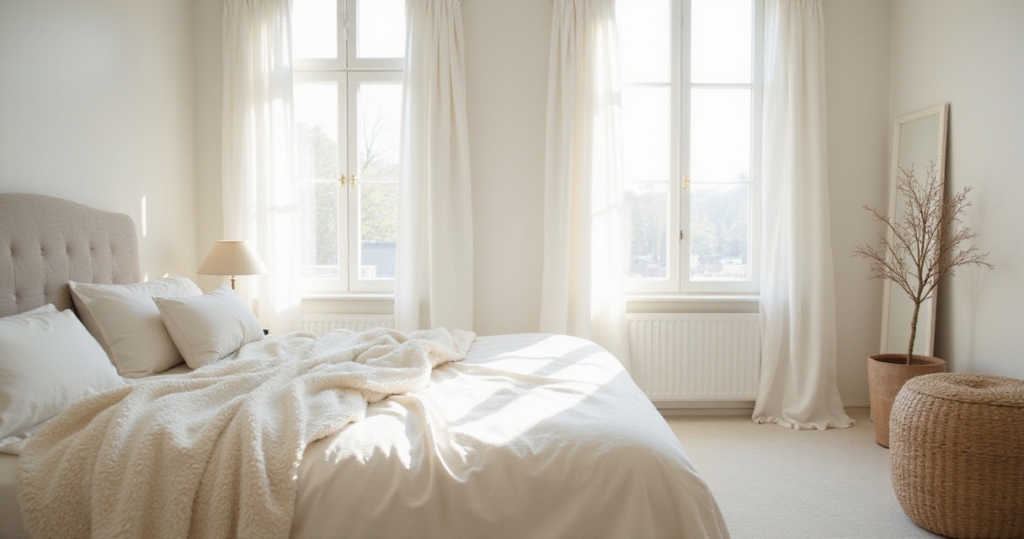The first light of morning. It doesn’t crash through the window; it seeps. It moves softly across a wall, catches the edge of a linen sheet, and illuminates the dust motes dancing in the air. This quiet arrival is the spirit of a White Bedroom. It’s a space that doesn’t shout for your attention, but rather, invites you to find your own peace within it.
In my work, I often return to the concept of ma (間). It’s a difficult word to translate, but it is the space between things—the silence between notes of music that gives the melody its power. A white bedroom, designed with intention, is the physical embodiment of ma. It isn’t an empty room; it’s a room full of potential, full of light, full of calm. So many of my clients in bustling cities come to me seeking refuge, a visual silence from the world. A white room offers that.
This isn’t about sterile, cold spaces. This is about creating a sanctuary. Forget the idea of a perfect, untouchable showroom. A home should bear the gentle marks of life. Through these ideas, I hope to guide you toward creating a bedroom that feels not just beautiful, but deeply and truly restorative.
1. Choose the White that Speaks to Your Light
Before you ever pick up a brush, you must sit in the room. Just sit. Watch how the light enters in the morning, how it stretches and warms at midday, and how it cools and fades into dusk. The “perfect” white is a myth; the right white is the one that understands your room’s unique light. To choose a paint is to begin a conversation with your space.
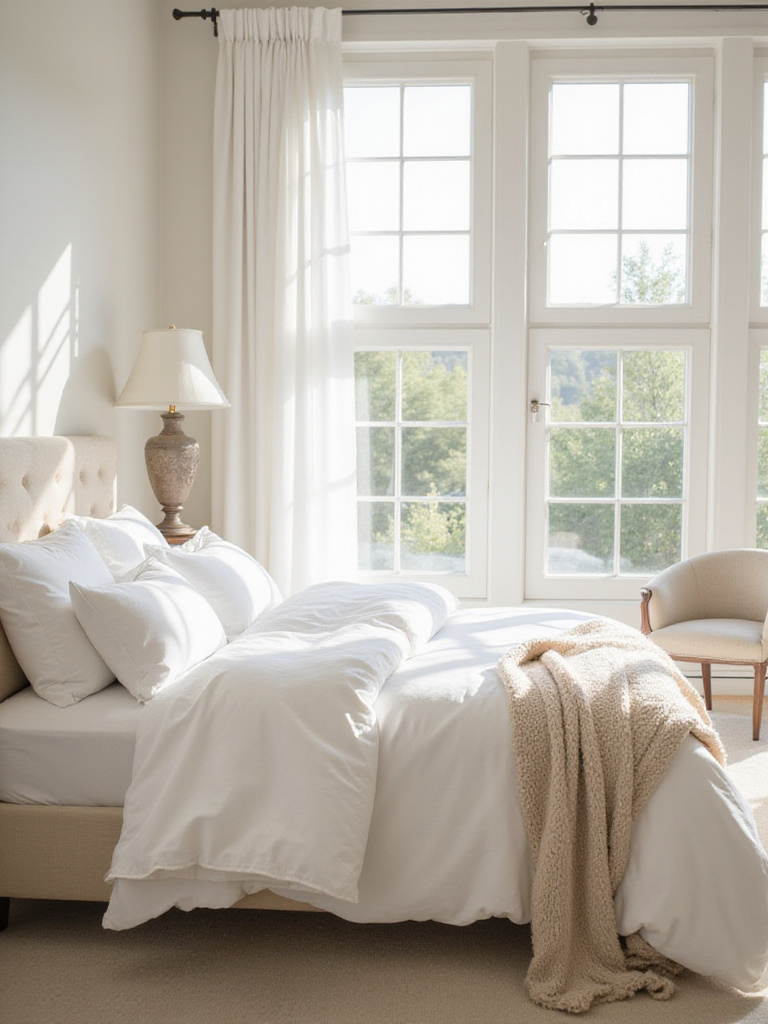
North-facing rooms, which hold a cool, gentle light all day, often feel brittle with a pure white. Here, you must bring in warmth. Think of the color of unbleached paper or warm sheep’s milk. A white with a subtle drop of yellow or pink, like Benjamin Moore’s “Cloud White,” can feel like a soft embrace. But in a south-facing room, bathed in strong, golden light, these same whites can turn almost yellow. Here, a cooler white with a hint of grey or blue—something like “Chantilly Lace”—will hold its crispness and feel clean and refreshing. I’ve learned this lesson the hard way. Early in my career, I specified a beautiful, warm white for a client’s south-facing Tokyo apartment. By 3 p.m., the room was screamingly yellow. Test your swatches on different walls, and live with them for a few days. You are choosing a partner for your room, not just a color.
This delicate interplay of light and undertone is where the room begins to find its soul.
2. Weave a Story with White Textures
A room with only flat, white surfaces would feel soulless. The real art of a white bedroom lies in its textures. This is where we can find a quiet expression of wabi-sabi (侘寂)—the beauty of things that are imperfect, impermanent, and humble. Texture is what keeps the eye and the hand engaged.
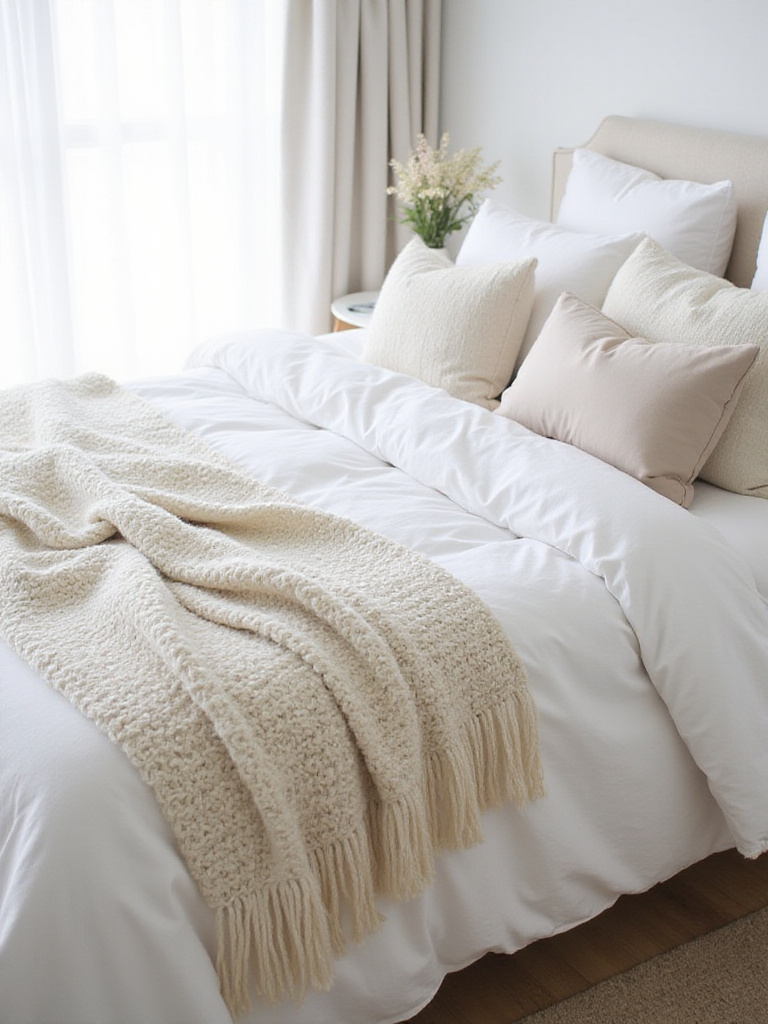
Think of it as composing a piece of music with a single note. How do you make it interesting? By varying its volume, its length, its feeling. Start with the foundation: crisp, cool percale sheets that feel smooth against the skin. Then, add a counterpoint. Perhaps a chunky wool blanket, knitted with intentional imperfections, laid across the foot of the bed. It adds visual weight and a sense of handmade warmth. A single velvet pillow can introduce a subtle, light-absorbing depth, while a silk one offers a touch of luster. The goal isn’t just to layer; it’s to create a conversation between the rough and the smooth, the matte and the luminous. Each material honors the one next to it.
Beyond the bed, the textures you choose set the entire mood for the space.
3. Build a Foundation of Light with Your Flooring
The floor is the largest single surface in your room. It’s a vast canvas that can either absorb light or reflect it. To create that sense of airy brightness we seek, the floor must become a source of light itself. It’s the reason traditional Japanese homes with light hinoki wood and tatami mats feel so open.

Wide-plank white oak with a natural, matte finish is a beautiful choice. It grounds the room with its organic grain but keeps the palette bright and warm. Its imperfections—the knots and subtle shifts in tone—tell the story of the tree it came from. For a home that needs more resilience, there are wonderful pale bamboos or even light-toned vinyls that mimic the look of natural wood. The goal is to minimize the visual boundary between the walls and the floor. When they flow into one another, even a small bedroom feels boundless. I’ve found that the simple act of choosing a floor with undertones that match your wall—creamy floors with warm whites, pale grey floors with cool whites—is what makes the room feel cohesive and whole.
With a floor that holds the light, you have a stage upon which to place the most important elements.
4. Ground the Space with the Warmth of Wood
A white room without the soul of natural materials can feel adrift. Wood is the anchor. It provides the necessary balance to white’s cool ethereality, reminding us of the earth and the passage of time. The warmth of wood is not just visual; it’s psychological. It feels solid, dependable, and alive.
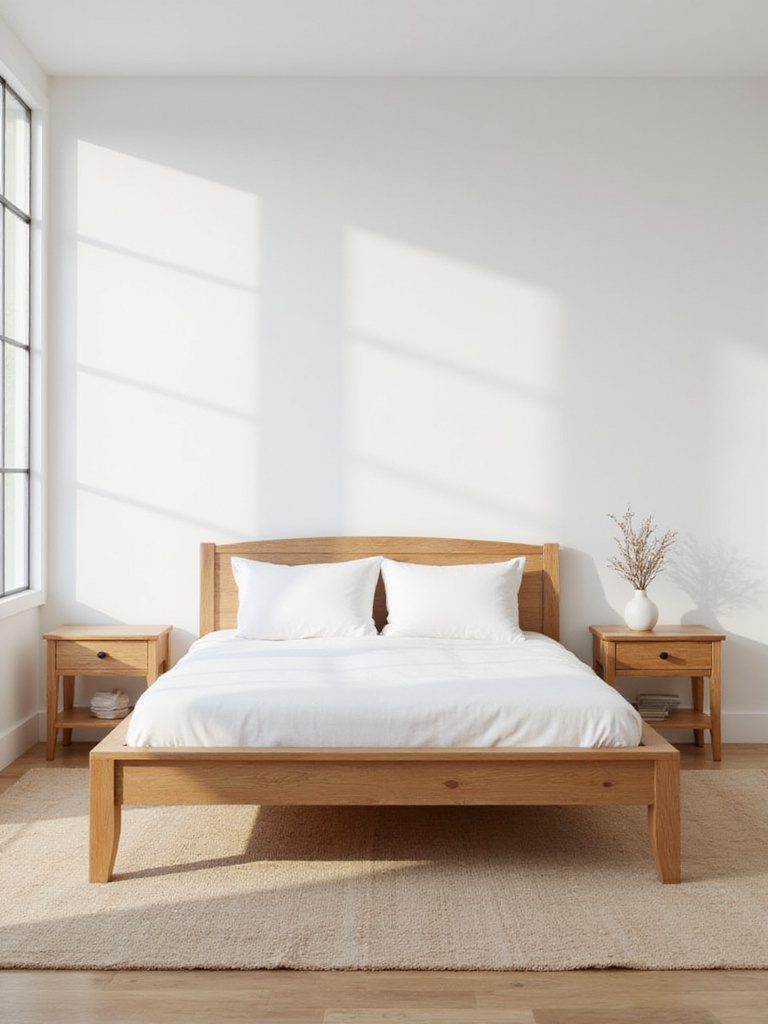
You don’t need much. One or two carefully chosen pieces are enough. I once worked on a project where we used a headboard made from a single, live-edge slab of walnut. Its dark, rich grain became the room’s focal point, a piece of natural sculpture. In another home, a simple oak dresser was enough to ground the entire space. The beauty is in the material itself. Look for pieces with visible joinery, where you can see the hand of the craftsman. This kind of integrity is something that mass-produced furniture can never replicate. Let the wood’s grain and color—be it honeyed oak, rich cherry, or pale ash—be the “color” in the room.
These natural elements create a dialogue with the clean lines of the white surroundings, bringing a necessary harmony.
5. Filter the Light with Sheer Curtains
In Japan, we have a long tradition of using shoji screens not to block light, but to transform it. Harsh, direct sunlight is tamed, diffused into a soft, tranquil glow that fills the room. You can achieve this same effect with sheer white curtains. They are the room’s lungs, allowing it to breathe with the changing light of the day.

Choose natural fabrics like linen or thin cotton voile. Their subtle, woven texture becomes visible only when the light passes through, creating a living piece of art that changes from dawn to dusk. Don’t skimp on the fabric; you’ll want two to three times the width of your window to create soft, generous folds. And here’s a trick I use in almost every project: mount the curtain rod as close to the ceiling as possible and extend it well beyond the window frame. This not only makes the window and the room feel taller, but it also allows you to pull the curtains completely clear of the glass, letting in every bit of precious light when you want it.
The gentle light filtering through these fabrics softens all the shadows in the room, creating an atmosphere of deep calm.
6. Sculpt the Mood with Layers of Light
A single overhead light is the enemy of a peaceful bedroom. It casts harsh shadows and creates a flat, uninviting atmosphere. A truly restorative space requires layers of light, allowing you to shape the ambiance to fit your mood and the time of day. This philosophy is rooted in In’ei Raisan (In Praise of Shadows), the understanding that beauty is often found in the subtle interplay of light and shadow.
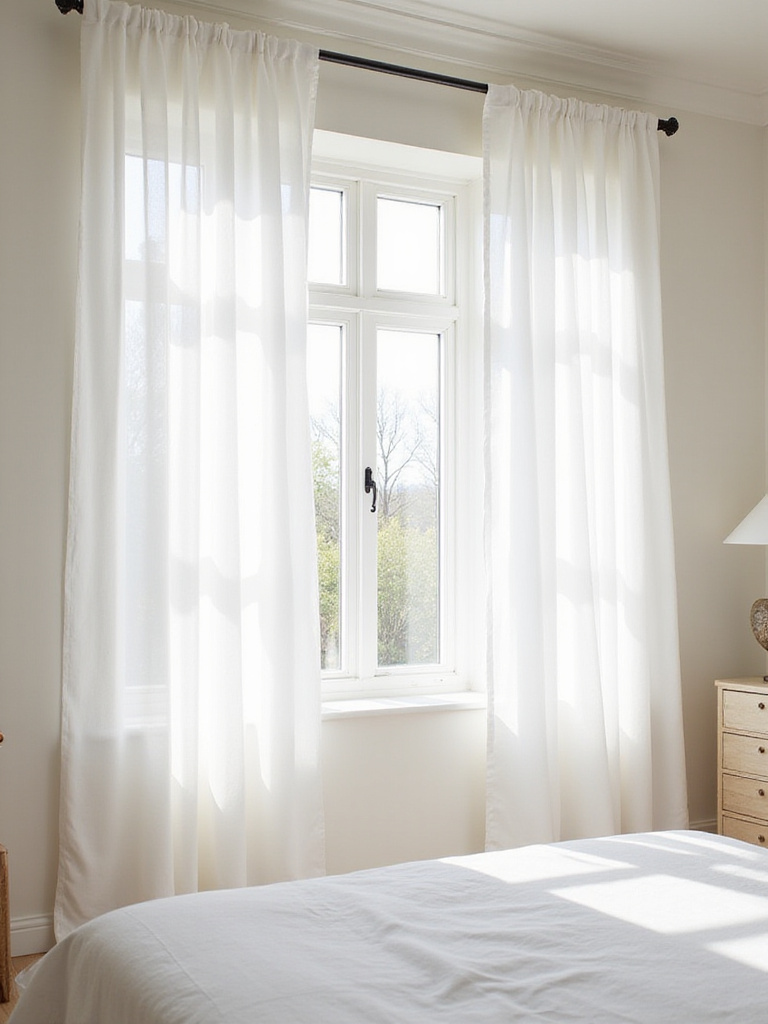
Start with a general, ambient layer—perhaps recessed fixtures with a warm glow, all on a dimmer. This is your functional light. Next, add task lighting. A pair of beautifully simple sconces on either side of the bed, or a focused reading lamp near a chair, provides light exactly where you need it, preventing eye strain. The final, magical layer is accent lighting. A soft uplight in a corner, highlighting the texture of a plant, or even a simple LED strip hidden behind a headboard to cast a halo on the wall. The real transformation happens when you can control these layers independently. You can move from bright and energizing for your morning routine to a soft, warm glow that tells your body it’s time to rest.
Light isn’t just for seeing; it’s for feeling. It guides our rhythm and nurtures our peace.
7. Punctuate the Silence with Black Accents
Think of a piece of Japanese calligraphy. The power is not just in the white paper, but in the sharp, deliberate stroke of black sumi ink. A few strategic black accents in a white bedroom serve the same purpose. They provide punctuation, structure, and a point of focus, preventing the serene space from feeling washed out.
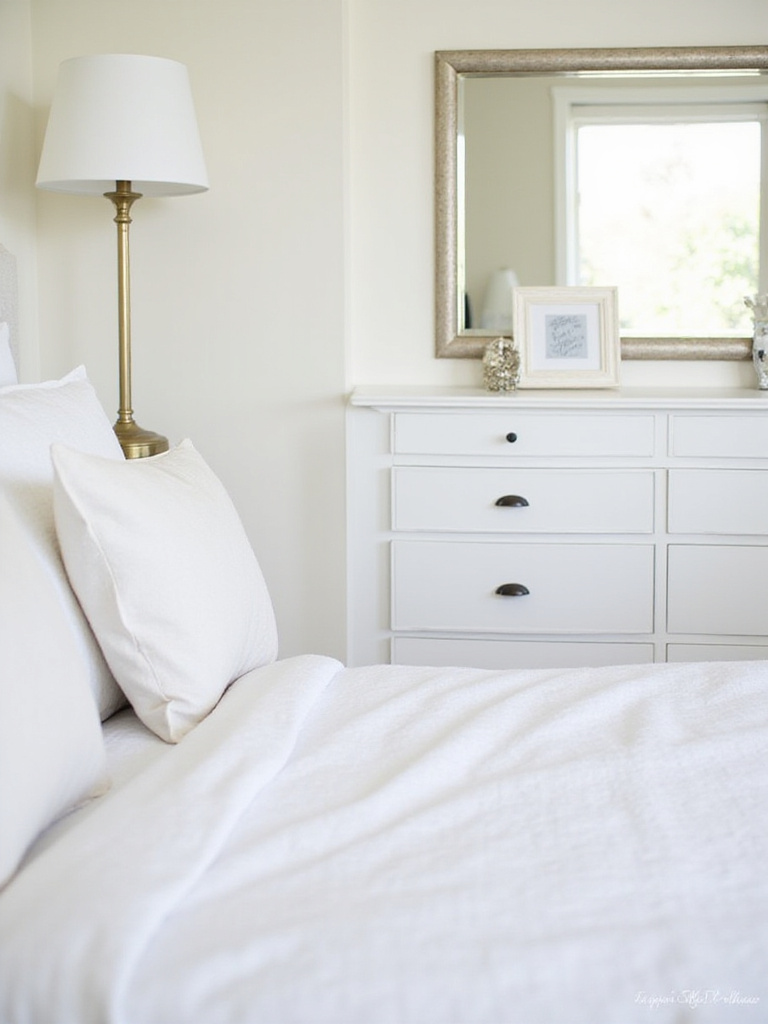
This isn’t about creating harsh contrast, but about creating definition. A slender black metal bed frame can become a beautiful line drawing in the room. The thin black frames around a collection of photographs, the matte black hardware on a white dresser, or the simple form of a black ceramic vase—these are the details that bring sophistication. The key is restraint. I often aim for just a small percentage of black, distributed thoughtfully. Too little feels like an accident; too much overwhelms the calm. Think of each black element as an anchor, holding the airy whiteness of the room in place.
This balance is what gives the composition its strength and keeps the eye engaged.
8. Anoint a Focal Point with a Statement Headboard
Your bed is the heart of the room. It should feel like a sanctuary within a sanctuary. A distinctive headboard can do this work for you, serving as the room’s clear focal point and establishing its character. It’s the piece that says, “Here is where rest begins.”
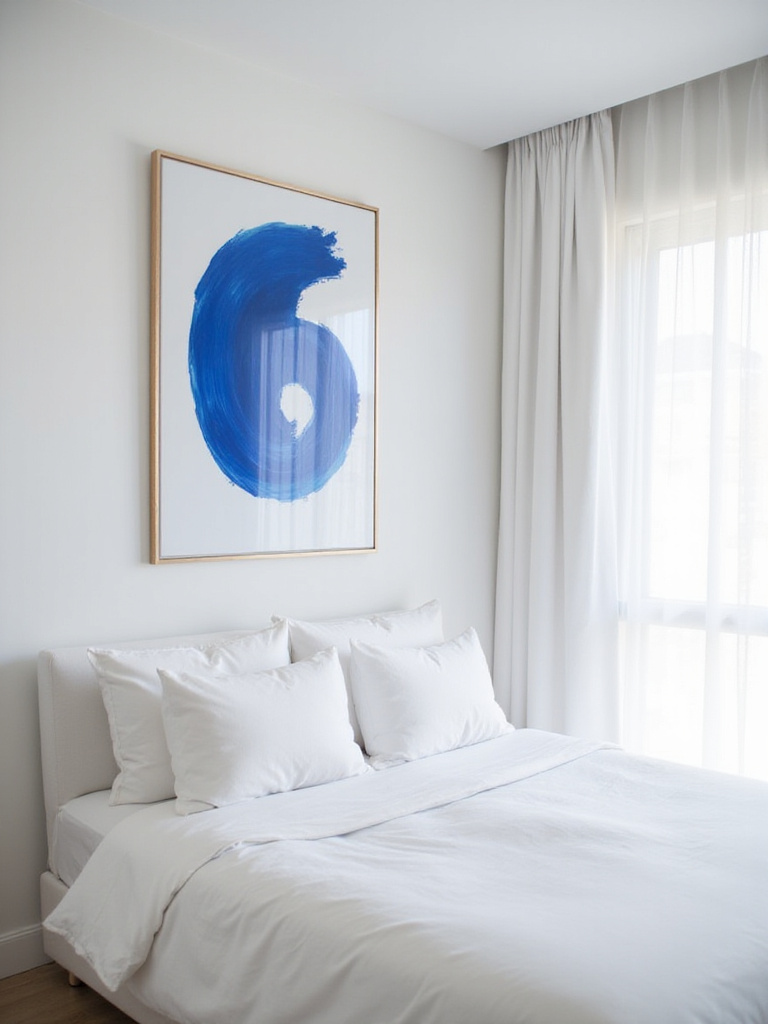
You can create a sense of softness and luxury with an oversized, upholstered headboard in a textured white or cream linen. The generous scale feels embracing and provides a comfortable support for reading. Or, you can bring in that essential natural element with a headboard made of bleached or reclaimed wood. The subtle variations in tone and texture tell a quiet story. In smaller rooms, I’ve found that a tall, even ceiling-height, headboard can draw the eye upward, creating a powerful illusion of spaciousness. In a larger room, a wider headboard that incorporates the nightstands can create a strong, grounding horizontal line.
What matters is that it has a presence, a weight that anchors your moments of rest.
9. Breathe Life into the Space with Living Plants
A white room yearns for life. Plants are the most beautiful way to provide it. Their vibrant green is the perfect, natural counterpoint to the white, and their organic forms soften the clean lines of a minimalist space. They are living, breathing sculptures.
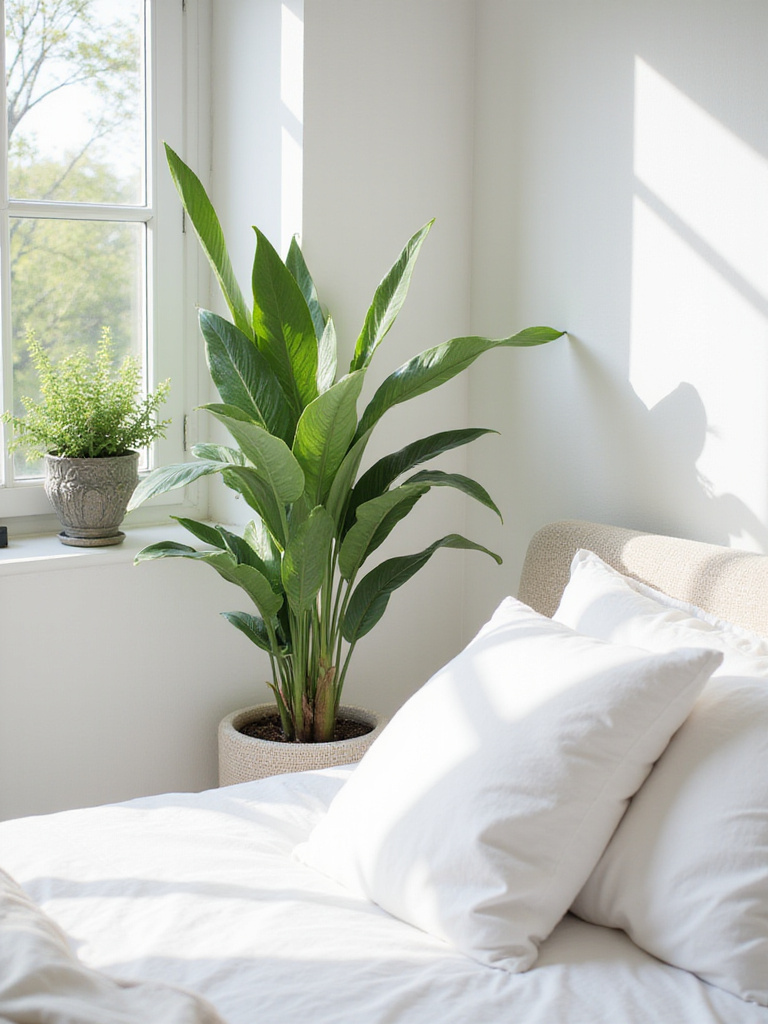
Choose plants that will thrive in your bedroom’s conditions. A snake plant is wonderfully architectural and famously forgiving, purifying the air while you sleep. A large fiddle leaf fig by a window can be a dramatic statement piece, its leaves casting beautiful, moving shadows across the walls. But it’s not just about aesthetics. Studies have shown what we intuitively know: being around greenery calms our nervous system and promotes a feeling of well-being. There is a deep, primal comfort in sharing your space with another living thing. Use simple ceramic pots in white or terracotta tones that don’t compete with the beauty of the plant itself.
A single, well-cared-for plant can infuse an entire room with vitality.
10. Carve Out a Space for Stillness with a Reading Nook
Even within the sanctuary of a bedroom, it’s a gift to have a smaller, dedicated space for quiet contemplation. A simple reading nook is an invitation to pause—to sit with a cup of tea in the morning or to unwind with a book before sleep. Find an unused corner, preferably near a window for natural light.
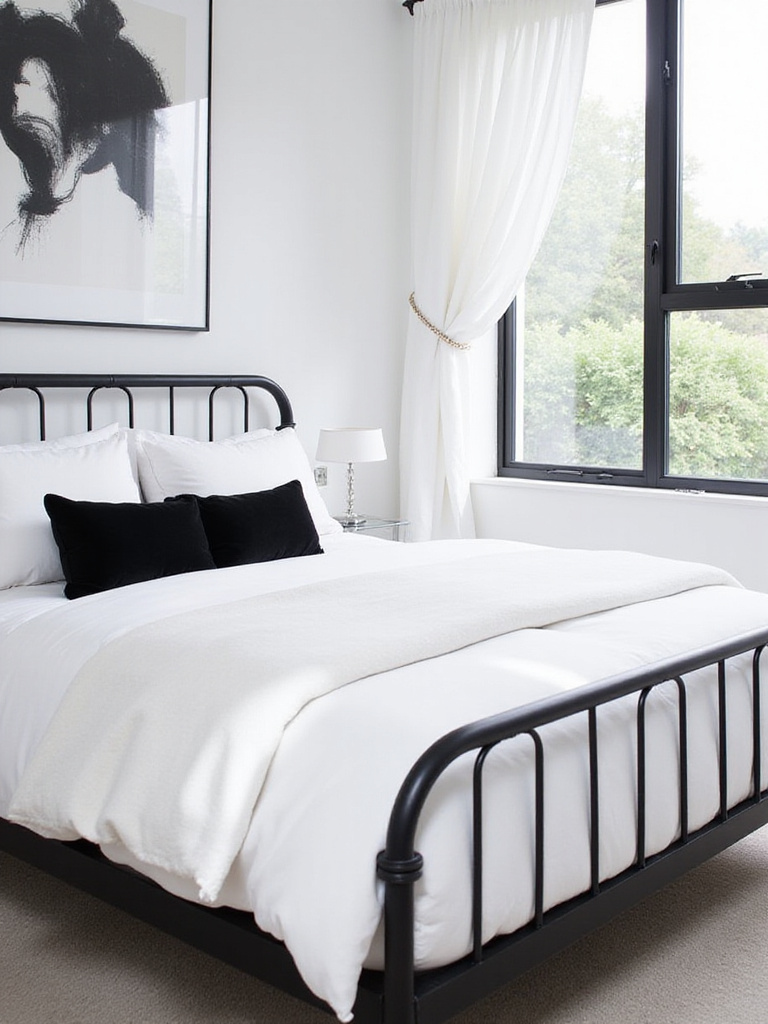
The key is a comfortable chair. Something upholstered in a soft, inviting white fabric like linen or a nubby bouclé. The form should welcome you to curl up, not sit formally. Beside it, place a small table in a light wood or a simple metal. It only needs to be large enough for a book and a cup. Add a soft throw for warmth, and most importantly, consider the light. A slim floor lamp with an adjustable arm gives you focused light for reading without flooding the entire room. This little corner becomes a destination, a deliberate space for disconnection.
It’s a retreat within a retreat, a space that honors your own inner life.
11. Find Freedom in Minimalist Furniture
Minimalism is not about deprivation. It is about an abundance of space, light, and mental clarity. Choosing minimalist furniture allows the room itself—its architecture, its light, its textures—to be the main feature. Each piece must justify its existence.
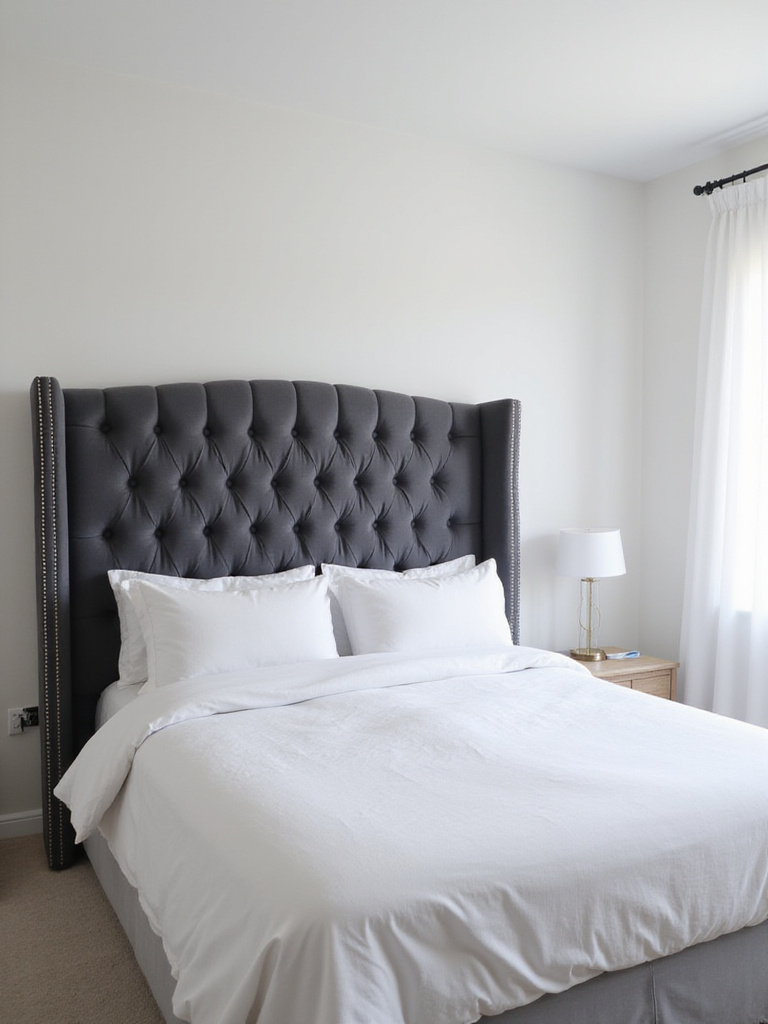
Look for furniture with clean, simple forms. A low-profile platform bed, perhaps with integrated nightstands, feels much lighter than a bulky traditional bedframe. Choose pieces that are raised on slender legs. This small detail allows light and air to flow underneath, creating a sense of openness and making the room feel larger. This is also where quality becomes non-negotiable. When you have fewer pieces, each one is more visible. Invest in solid wood, in beautiful joinery, in hardware that feels good in your hand. Each piece should be chosen not just for its function, but for the quiet beauty of its form.
Resist the urge to fill every wall. The empty space, the ma, is what allows the pieces you truly love to breathe.
12. Bring Calm by Concealing Clutter
Our lives are full of things. To pretend otherwise is unrealistic. A serene bedroom, therefore, must be masterful at concealing this necessary clutter. Visible mess creates visual noise, and visual noise is the enemy of rest. Hidden storage is the key to maintaining that peaceful, uncluttered feeling.
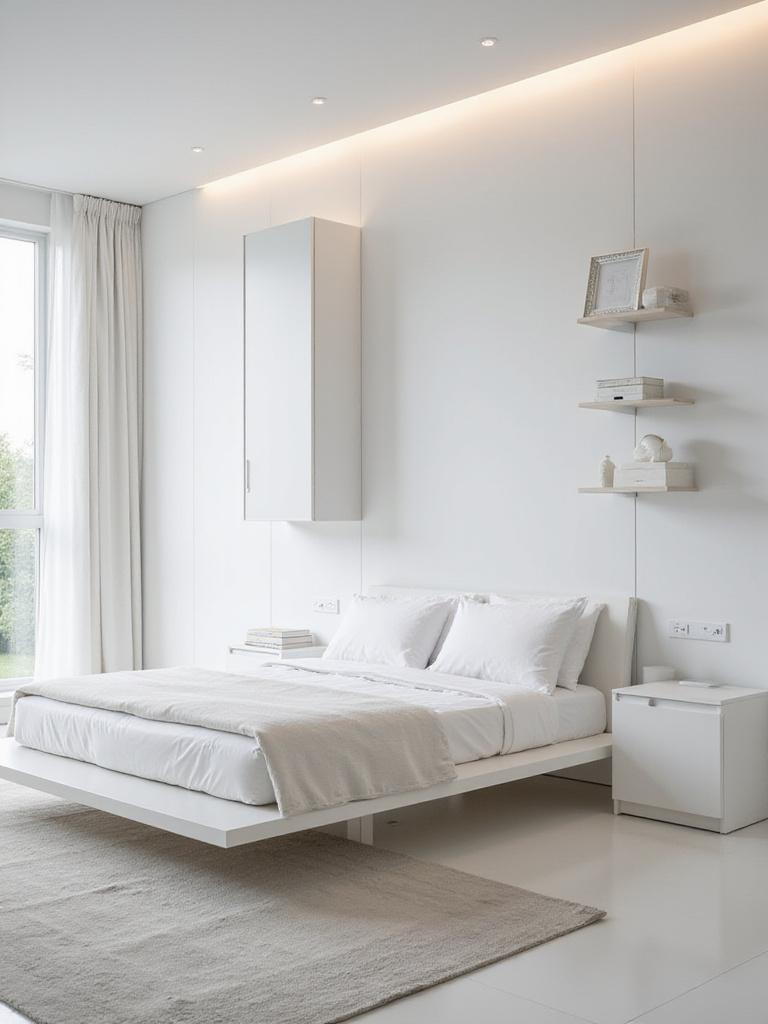
I am a great admirer of platform beds with hydraulic lifts. They reveal a vast storage space underneath—perfect for seasonal clothing, extra bedding, or luggage. It’s completely invisible yet easily accessible. Another wonderful solution is to build wardrobes that are painted the exact same white as the walls. Without contrasting lines or bulky hardware, they simply disappear into the architecture, providing immense storage without visually shrinking the room. Look at your space with fresh eyes. Can a deep windowsill become a window seat with storage below? Can the wall above a doorway hold a discreet, high shelf for things you rarely need?
The goal is to create a sense of effortless order, where everything has its place and your mind is free to rest.
13. Signal Rest with Warm LED Lighting
The quality of our artificial light profoundly affects our sleep. The blue-toned light from our screens and many standard light bulbs mimics daylight, signaling our brains to stay awake and alert. For a bedroom, this is a disaster. To encourage relaxation, your evening light should be warm, soft, and gentle, like the glow of a candle or a sunset.
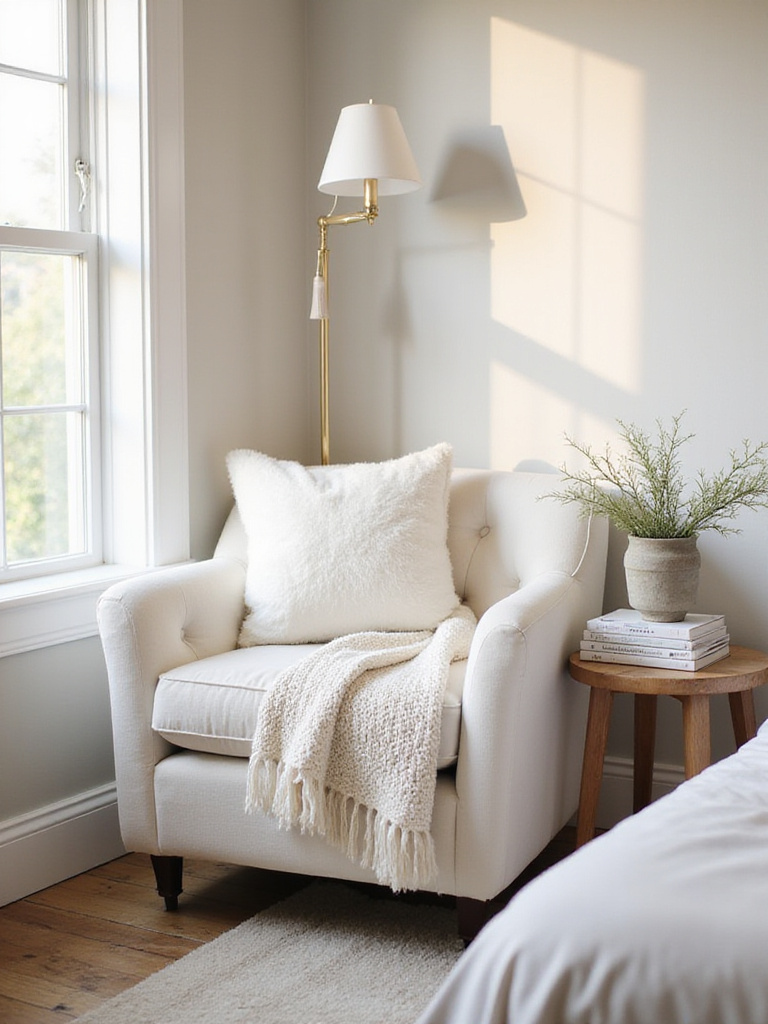
Switch every bulb in your bedroom to a warm LED, something below 3000 Kelvin. The difference is immediate and palpable. And every single light source should be on a dimmer. This is not a luxury; it’s essential. It allows you to slowly transition the room from day to night, sending a gentle signal to your body that it is time to wind down. Smart lighting systems can even automate this, gradually warming the color temperature as the evening progresses. Use lamps with fabric shades that diffuse the light beautifully, creating soft pools of illumination instead of harsh glare.
This simple change can have one of the biggest impacts on the quality of your sleep and the peaceful feeling of your room.
14. Amplify Light and Space with Mirrors
A mirror is a magical tool in a designer’s kit. It doesn’t just show a reflection; it multiplies light, creates an illusion of depth, and brings the outside world in. In a white bedroom, its power is magnified.

The most effective placement is almost always opposite a window. A large, simple mirror there will act like a second window, grabbing all that natural light and bouncing it deep into the room. It also reflects the view—the green of a tree, the blue of the sky—creating a living, changing piece of art on your wall. I personally love frameless mirrors or those with very simple, thin frames in a metallic or white-painted wood finish. You want the effect of the mirror, not the frame itself, to be the focus. A tall, floor-length mirror leaning against a wall can make a small room feel dramatically larger and more gracious.
The play of reflected light and movement adds a layer of vitality that prevents the room from ever feeling static.
15. Tell a Story with Curated White Accessories
A monochromatic space finds its personality in the subtle details. Styling your surfaces is not about adding clutter; it’s about arranging a few meaningful objects into a quiet, beautiful composition. This is where you can express yourself, but with restraint.
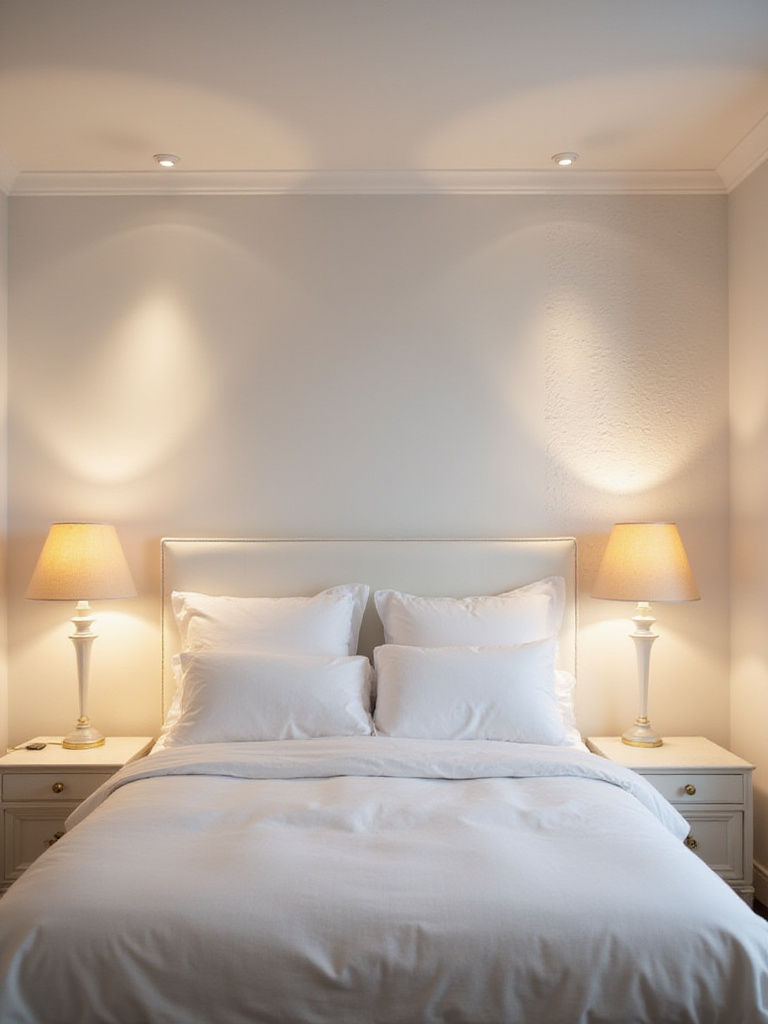
The secret is to vary shape, material, and texture. On a dresser, you might place a smooth, glossy ceramic vase next to a rough, matte plaster sculpture and a small, milky-white glass bowl. Though all are white, the way they catch the light and feel to the hand is completely different. Group items in odd numbers—threes or fives—and at varying heights. A composition of a tall object, a medium object, and a small, low object is almost always more pleasing to the eye than a symmetrical arrangement. Remember the ma. The space between the objects is as important as the objects themselves. Let each one have room to be seen.
These small, personal touches are what transform a well-designed room into your home.
16. Add a Single, Soulful Pop of Color
Sometimes, the most profound silence is the one that is punctuated by a single, beautiful sound. In a white room, a single, intentional pop of color can have the same effect. It gives the eye a place to rest and adds a layer of personality and emotion. The key, and this is crucial, is one. One color, used with purpose.
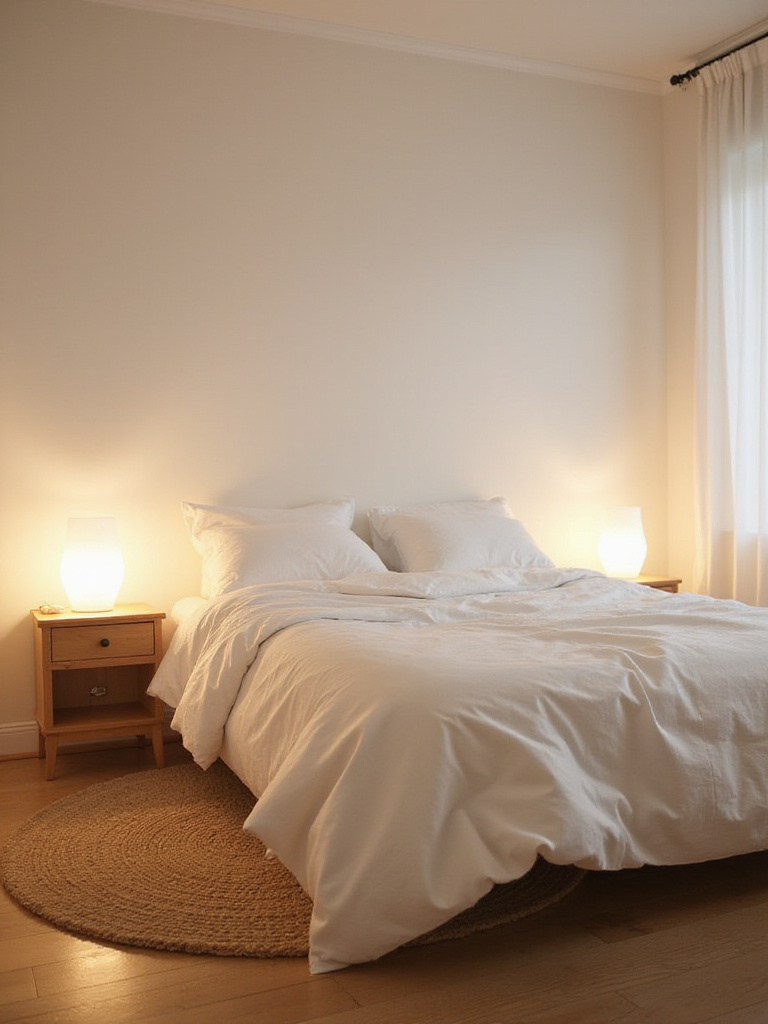
It could be a single piece of abstract art with deep indigo blues. Or two throw pillows in a muted, earthy ochre. It could simply be the deep, vibrant green of a beloved plant. The restraint is what gives the color its power. If you add two or three different colors, they begin to compete and the sense of calm is lost. Notice how your chosen color feels in the room’s light. A warm color will glow in the morning sun, while a cool color will feel more stable throughout the day. The color should feel like a discovery, a little moment of joy in the serene landscape.
It’s a whisper, not a shout, but it makes the whole room sing.
17. Invest in the Intimacy of Quality White Bedding
Your bed is the one place in your home where you are at your most vulnerable. The fabrics that touch your skin for hours every night should be a worthy investment. High-quality white bedding is the foundation of both comfort and the crisp, clean aesthetic of a restorative bedroom.
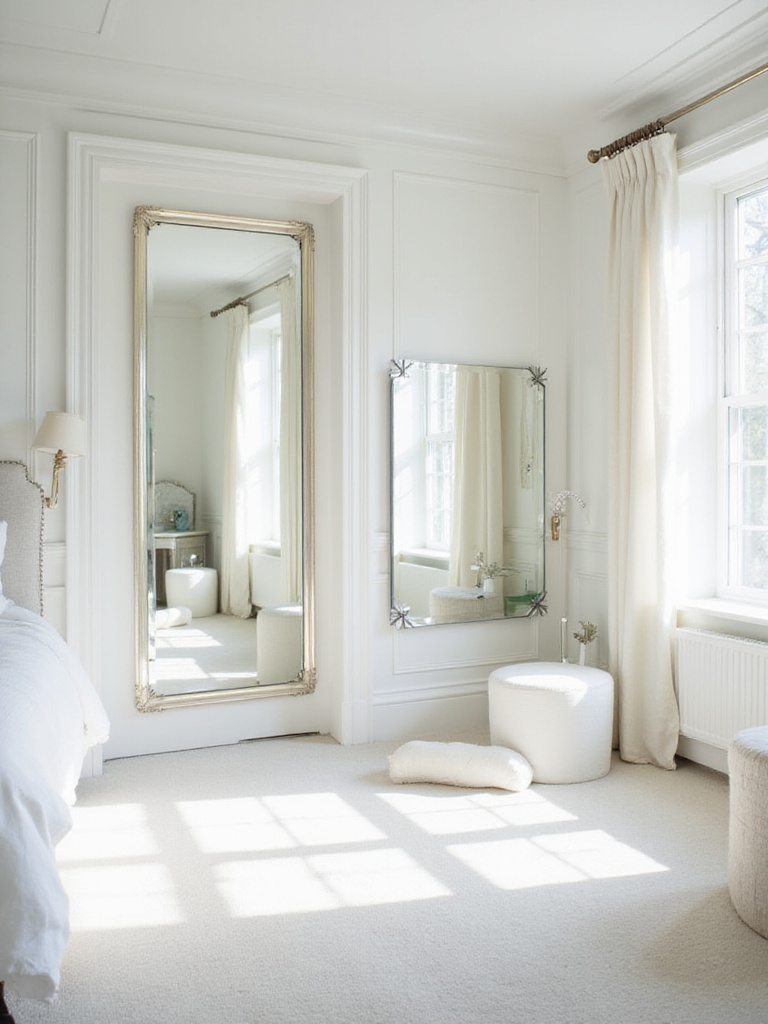
Please, forget about thread count. It is mostly a marketing gimmick. What truly matters is the quality of the fiber. Look for long-staple cottons like Pima or Egyptian, or high-quality linen. These materials are stronger, softer, and more breathable, and they actually improve with washing. They resist pilling and feel beautiful for years. You can feel the difference immediately. Layer your pieces for comfort and visual interest: a perfectly fitted sheet, a smooth top sheet, and a simple duvet cover. Don’t worry about matching everything perfectly. A mix of slightly different shades of white and different textures (a linen duvet cover with percale sheets, for instance) creates more depth.
This is an investment not just in your room’s beauty, but in the quality of your rest.
18. Embrace the Honesty of Natural Textures
To keep a white room from feeling synthetic or sterile, you must invite in the honest, humble beauty of natural textures. Materials like jute, rattan, and raw linen bring an organic warmth and imperfection that is deeply calming.
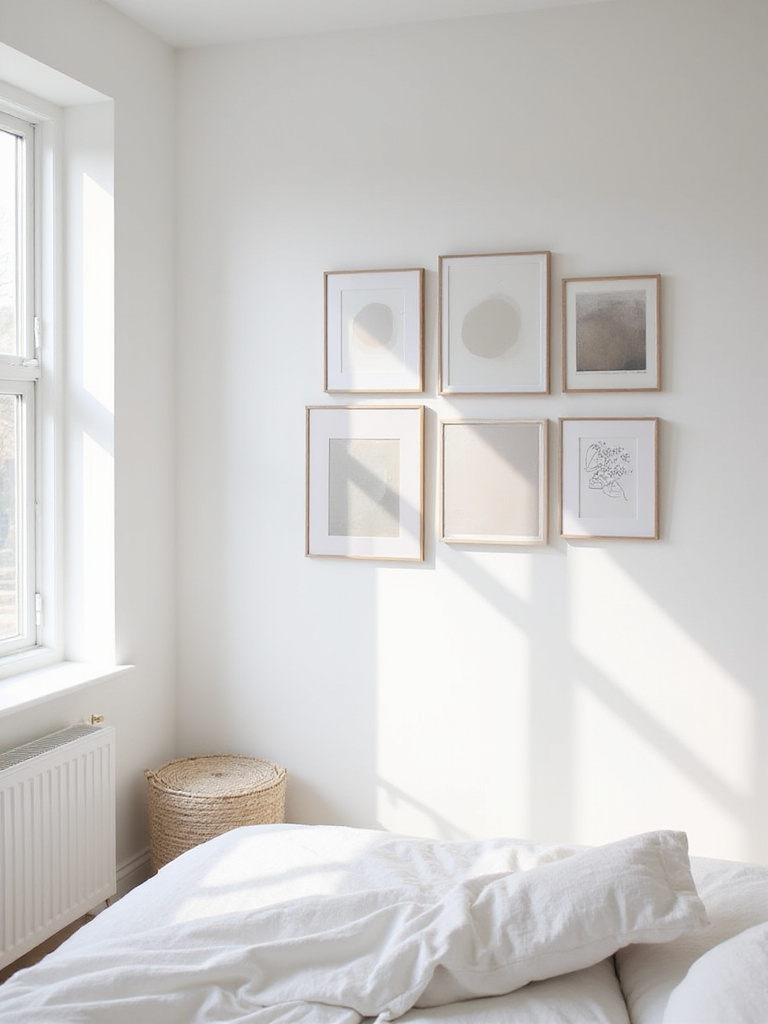
A large area rug made of jute or sisal is a wonderful way to ground the bed. Its texture is satisfying underfoot, and its natural, earthy color provides a subtle warmth without introducing a strong color. A woven rattan light fixture can cast beautiful, intricate shadows, and simple rattan baskets are perfect for holding a throw blanket or a few magazines. These materials tell a story of their own—of the hands that wove them, of the places they came from. Linen curtains become softer with every wash, developing a relaxed, lived-in beauty that synthetics can never mimic.
These textures connect our modern homes to the natural world, and that connection is inherently peaceful.
19. Curate Your Nightstand as a Sacred Space
Your nightstand is the last thing you see at night and the first thing you see in the morning. It should be a space of intentional calm, not a chaotic catch-all for the debris of the day. The act of curating your nightstand is a small, daily ritual of mindfulness.
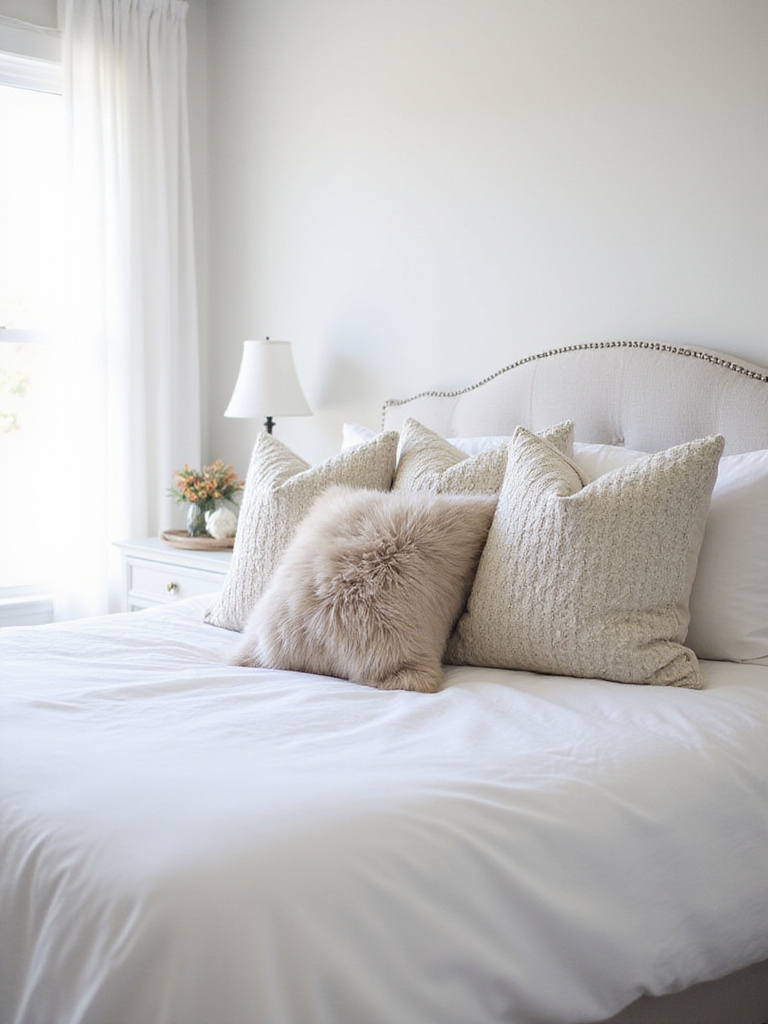
Edit ruthlessly. All it truly needs to hold are the essentials for your transition into and out of sleep. A good lamp for reading. A small dish for rings or a watch. A single book. A glass of water. Everything else should be stored away in a drawer. Choose items that are as beautiful as they are functional. Perhaps the lamp has a simple ceramic base, or the dish is handmade. Every object should earn its place. I have seen clients’ entire sense of evening peace shift just by clearing their nightstands.
It’s a tiny altar to rest. Treat it as such.
20. Define the Sanctuary with an Area Rug
An area rug is what defines the sleeping area as a distinct zone within the room, a soft island of comfort. In a white bedroom with light floors, a rug is essential for adding warmth, absorbing sound, and providing a soft surface for your feet to land on in the morning. It completes the space.
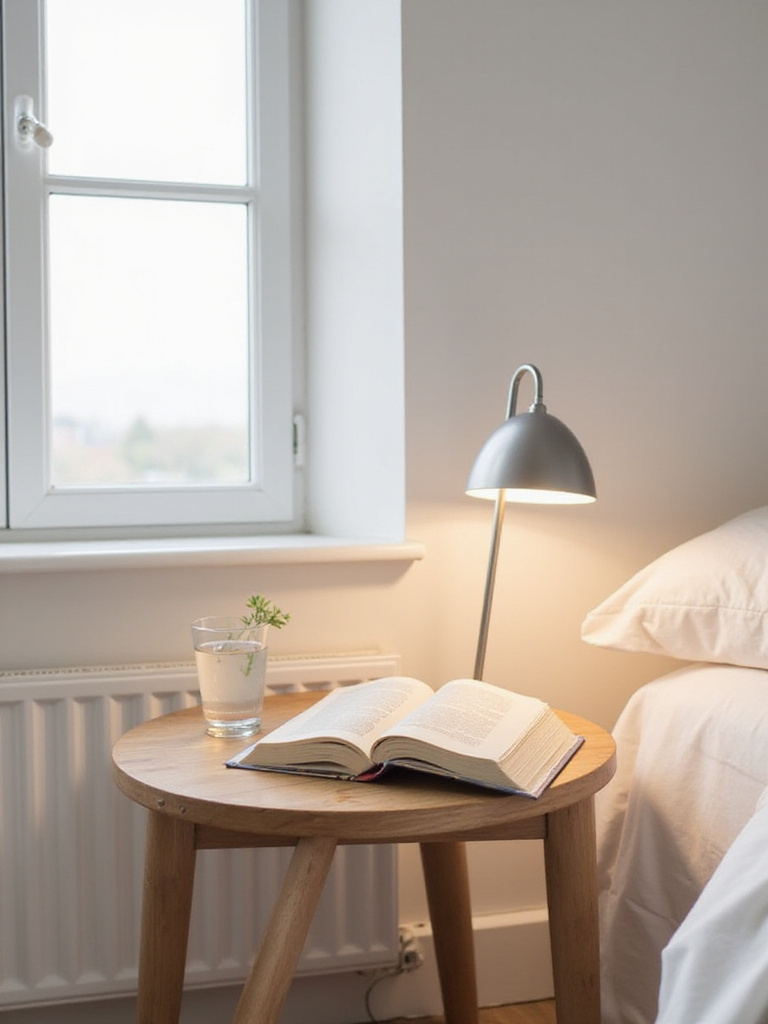
The rug should be large enough to extend at least 18 inches, and ideally 24 inches, out from the sides and foot of your bed. This generous sizing is what makes the bed feel properly grounded. You can choose a simple, plush white or cream rug to continue the monochromatic theme while adding deep texture. Or, this is a wonderful place to introduce that natural fiber element, like a wool or jute rug in a neutral tone. Layering is also a beautiful option: a large, flat-weave jute rug with a smaller, softer, plush white sheepskin rug layered on top, just where you step out of bed.
It’s the final gesture that pulls the entire sleeping composition together.
21. Add Dimension with White Wood Paneling
A flat, white wall can sometimes feel, well, flat. A beautiful way to add architectural interest and subtle depth without introducing color is with wood paneling, painted the same white as the walls. The play of light and shadow across the paneled lines adds a rich, textural quality.

Shiplap, with its clean horizontal lines, can make a room feel wider and more expansive. Board and batten, with its vertical emphasis, can make ceilings feel higher and more grand. Even a simple beadboard wainscoting can add a layer of classic charm. The key is in the precision of the installation and the quality of the finish. White is unforgiving of mistakes. But when done well, the subtle shadow lines create a rhythm and depth that is deeply satisfying and prevents the room from feeling stark.
The wall is no longer just a surface; it becomes a piece of quiet architecture.
22. Introduce the Warm Gleam of Metallic Accents
A small touch of metal can act like a piece of jewelry in a simple outfit. It adds a touch of sophistication and reflects light in a way that no other material can. In a white room, a few carefully chosen metallic accents can add warmth and a subtle glamour.
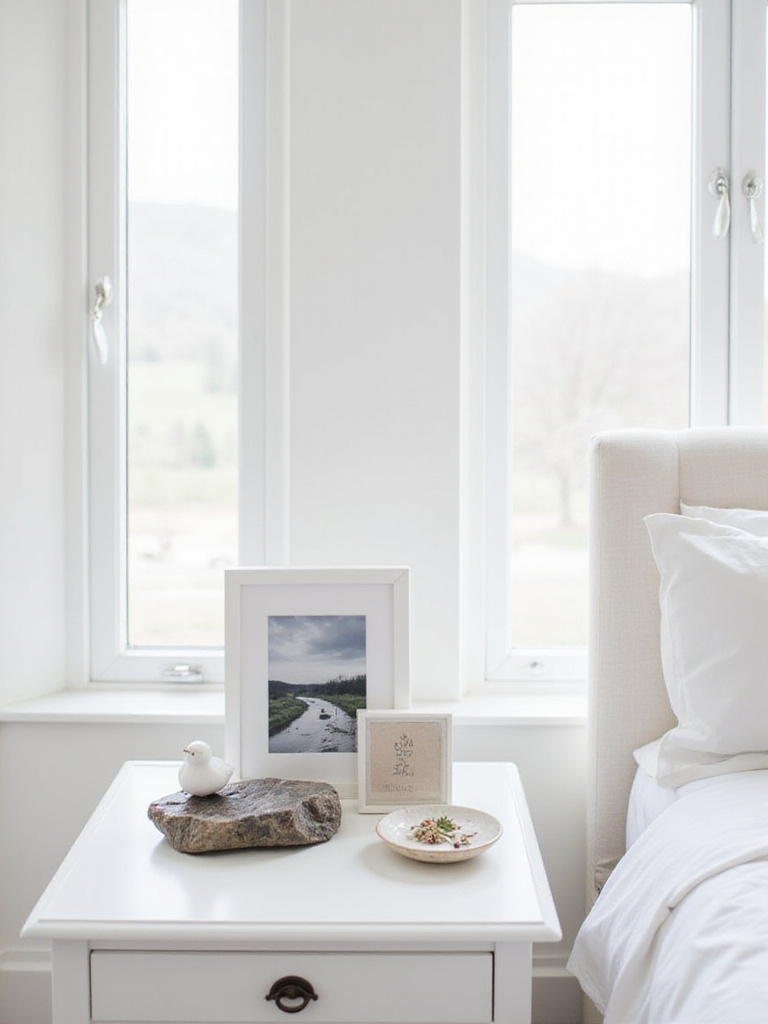
The secret is to choose one metal and carry it through the space. Brushed brass has a beautiful, soft warmth that pairs wonderfully with creamy whites. Polished chrome or brushed nickel has a cooler, more contemporary feel that works well with pure, crisp whites. It doesn’t need to be much: the base of a lamp, the thin frame of a mirror, the hardware on your dresser. These small, consistent touches create a cohesive and elegant look. You can even mix finishes within the same metal family—a matte brass light fixture paired with a polished brass tray—for more sophisticated depth.
It’s a quiet sparkle that elevates the entire space.
23. The Gentle Practice of Maintaining a White Room
A white room asks for a certain mindfulness. It asks for us to be present and to care for our surroundings. Maintaining its pristine beauty is not a chore, but a gentle practice that reinforces the calm you’ve worked to create.
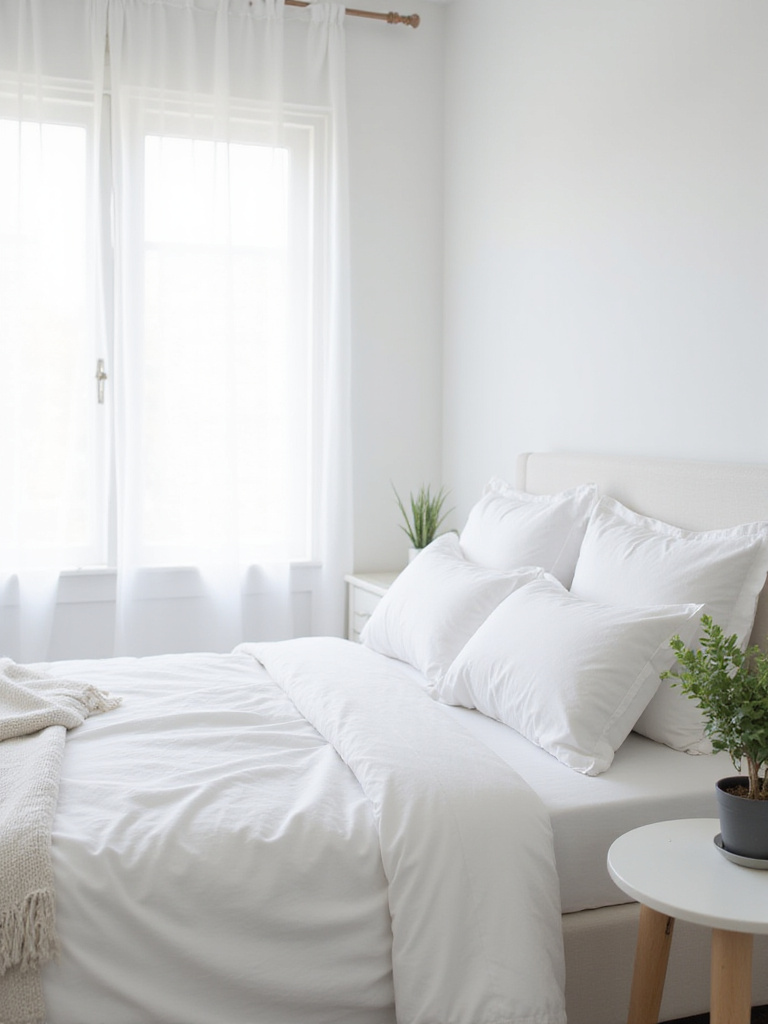
It simply means developing small, consistent habits. Wiping down surfaces with a microfiber cloth weekly to prevent dust from settling. Making the bed each morning to restore a sense of order. Addressing a small scuff or a spill when it happens, rather than letting it set. Think of it as a form of meditation. When you care for your space, your space, in turn, cares for you. Choosing high-quality, washable materials from the start makes this process infinitely easier. The effort is small, but the reward—a consistently peaceful and beautiful sanctuary—is immense.
The journey with a sustainable, well-made piece is one of care, not of consumption and replacement.
Conclusion
Creating a white bedroom is not an endpoint. It’s a beginning. It is an act of carving out a space for your own well-being in a loud and demanding world. Each of these ideas is simply a starting point, a guidepost on your own journey.
The real beauty of a white bedroom is not in its perfection, but in its ability to become a quiet backdrop for your life. It’s the way the morning light lands on your pillow, the feeling of a soft wool blanket on a cool evening, the peace you feel when you walk in and close the door. Begin with one or two thoughts that resonate with you. Start small. The goal isn’t to create a picture from a magazine, but to craft a sanctuary that holds you, nurtures you, and offers you a place of genuine tranquility. That journey, I promise, is one of the most rewarding you can take.
